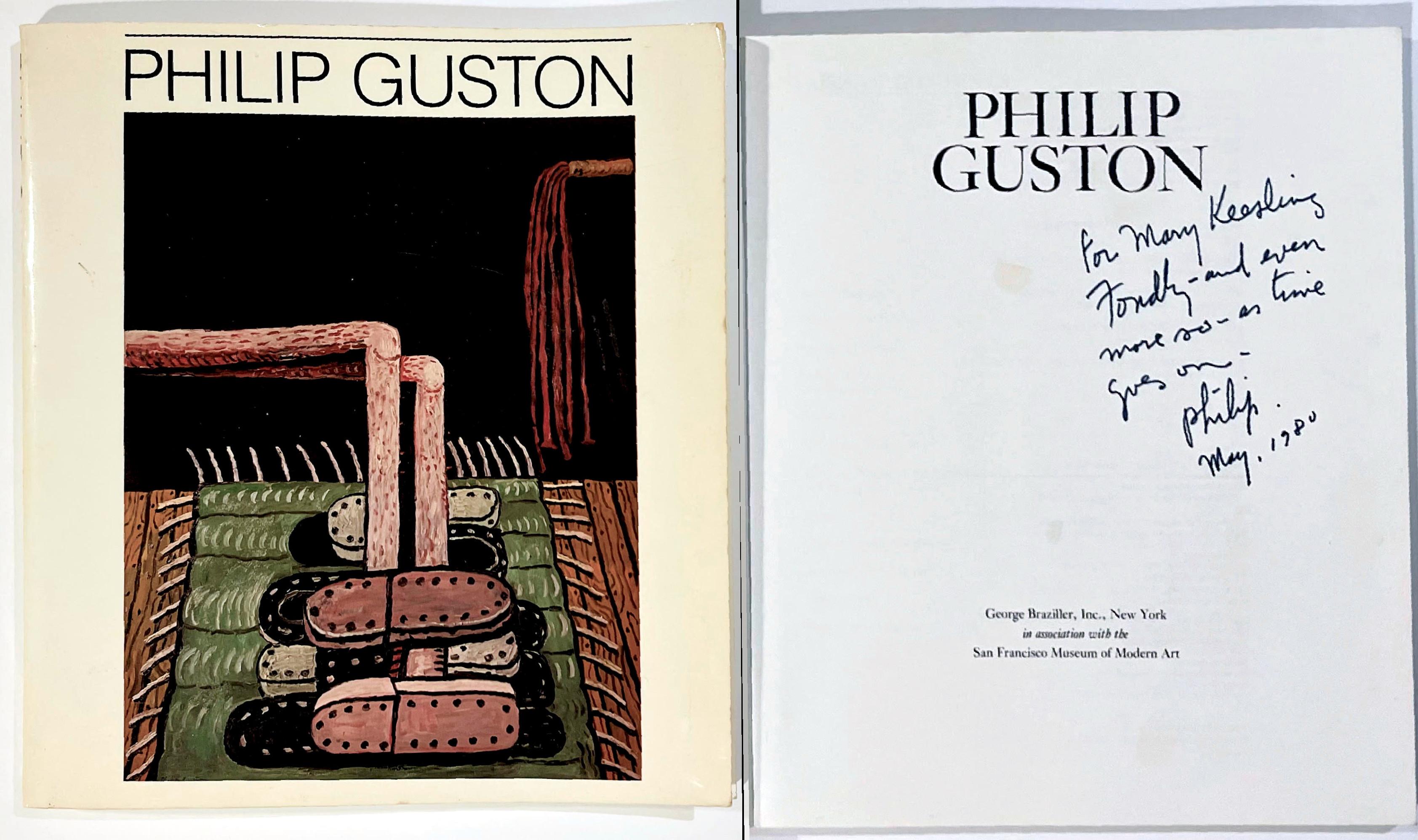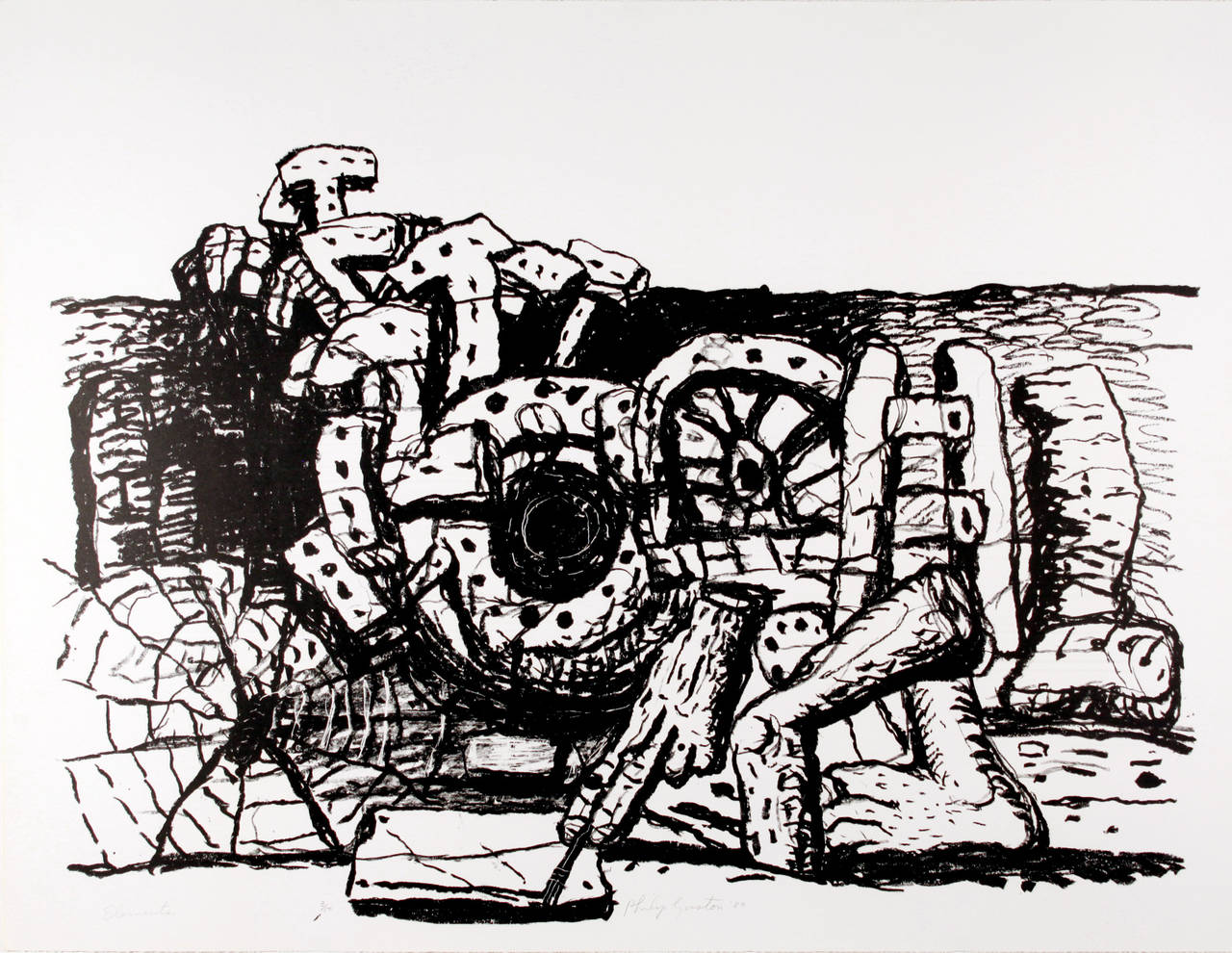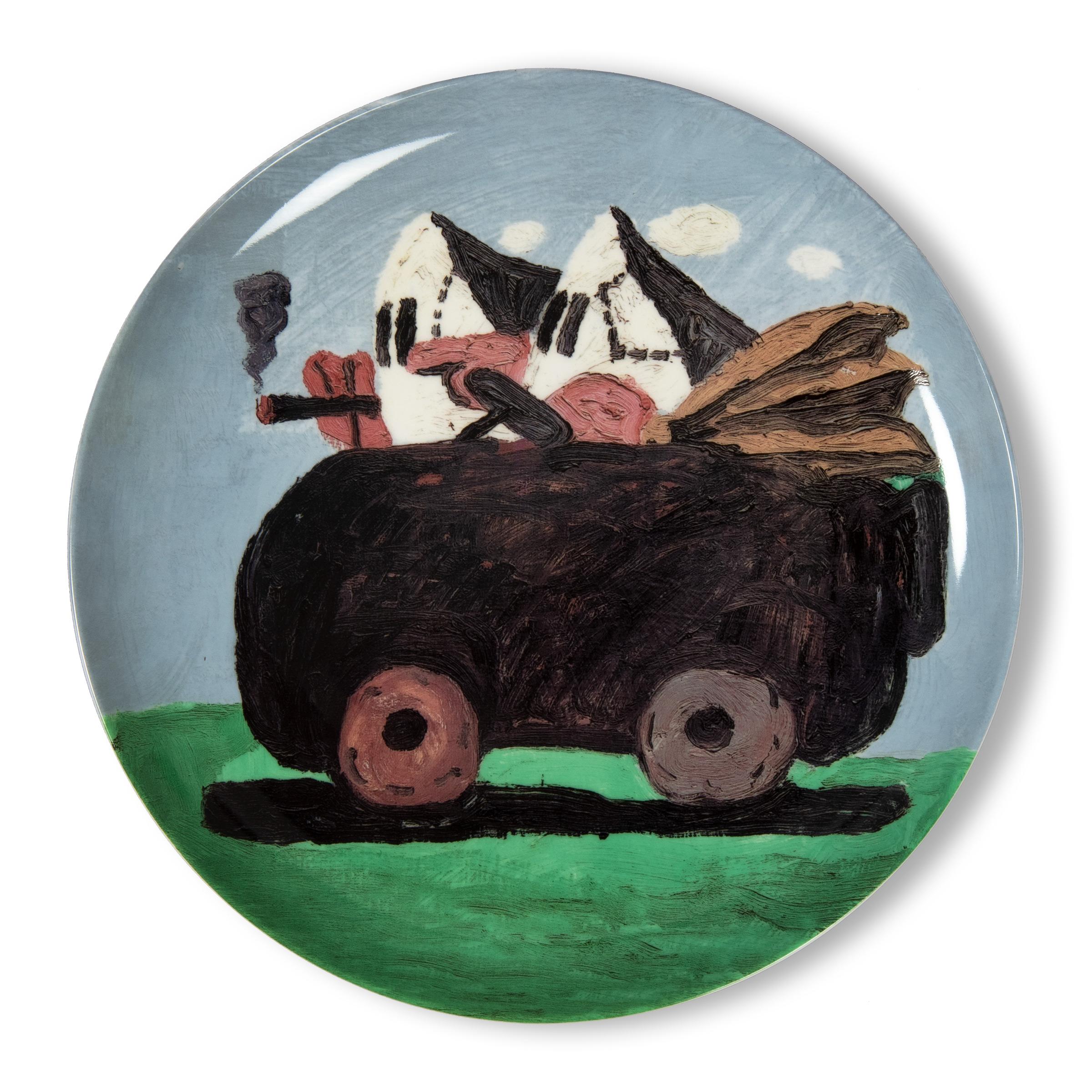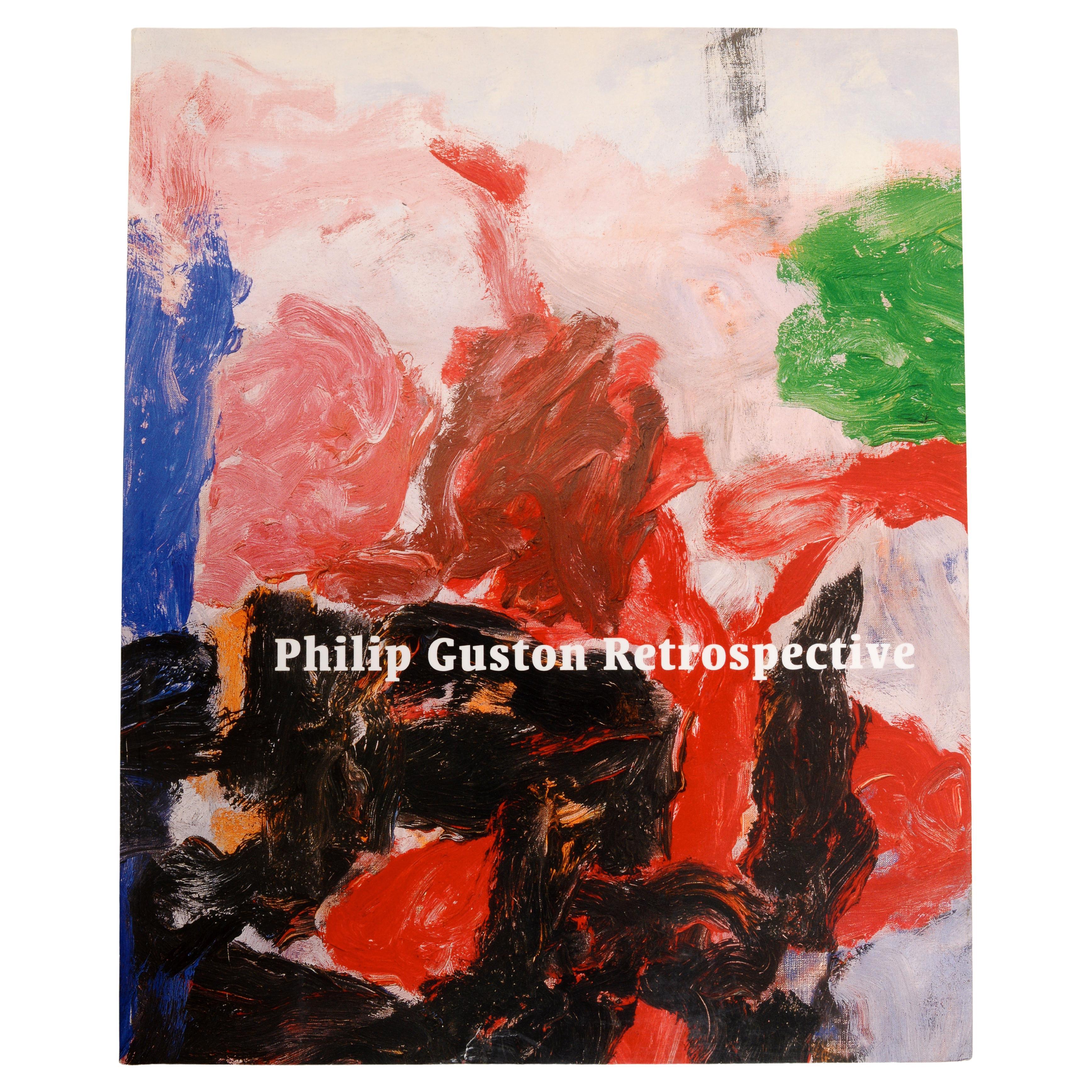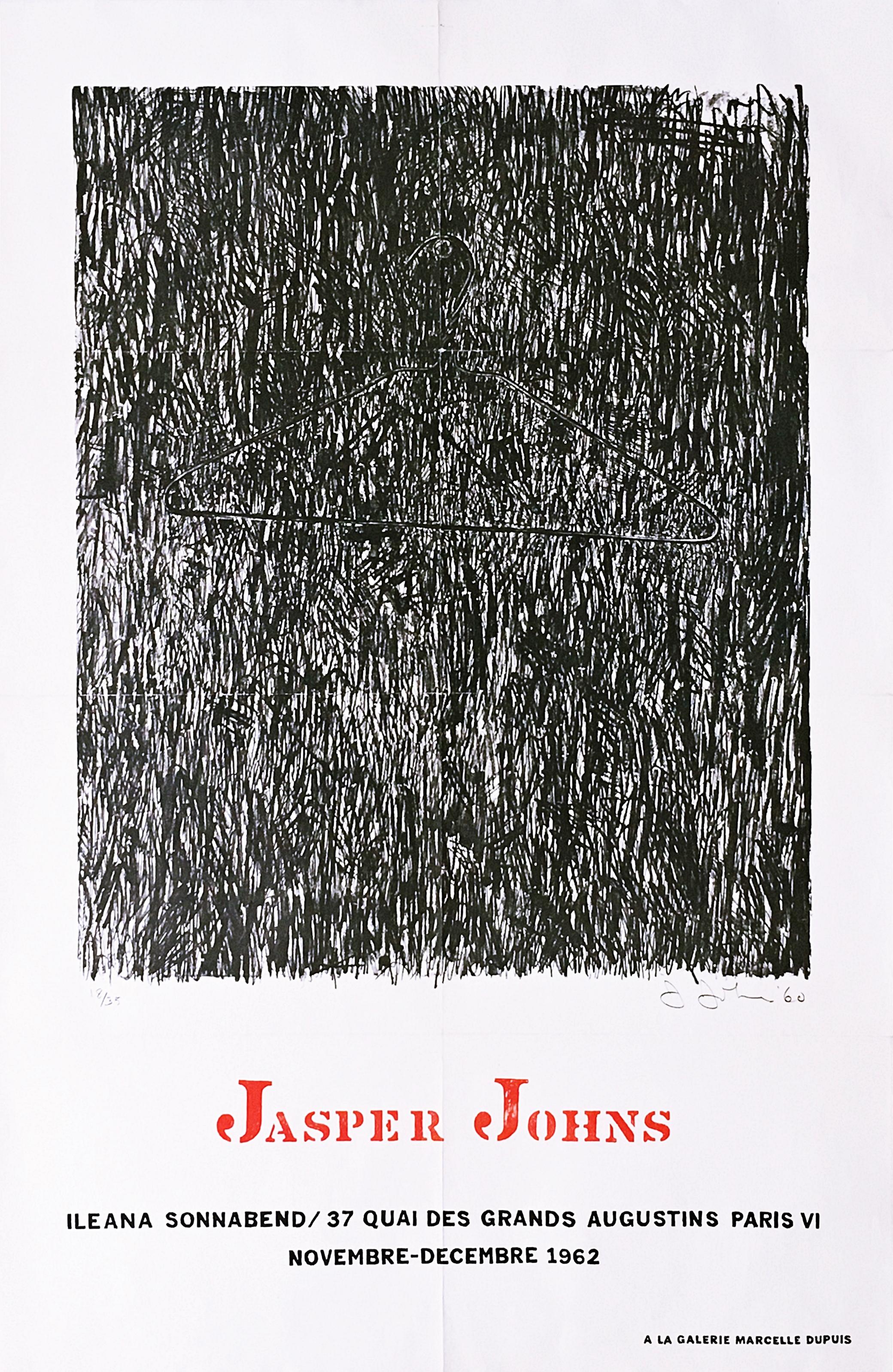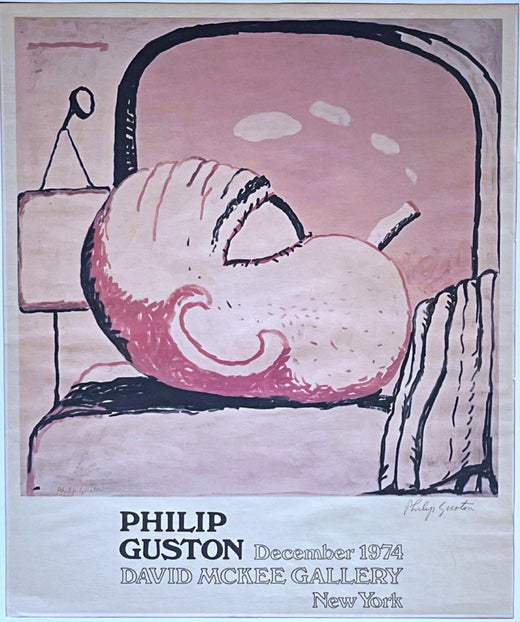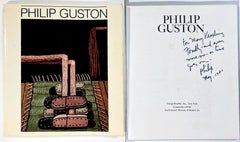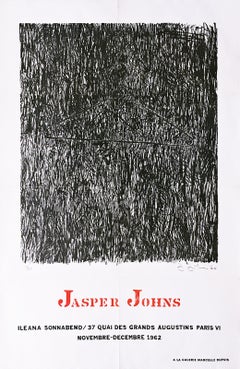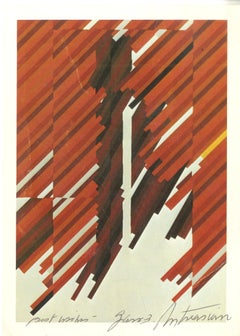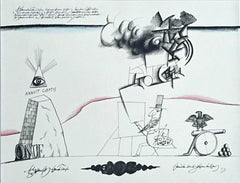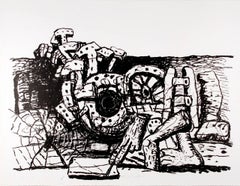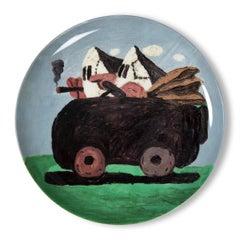Items Similar to Rare 1970s offset lithograph exhibition poster (pencil signed by Philip Guston)
Want more images or videos?
Request additional images or videos from the seller
1 of 6
Philip GustonRare 1970s offset lithograph exhibition poster (pencil signed by Philip Guston)1974
1974
$5,000
£3,905.40
€4,427.23
CA$7,168.06
A$7,862.97
CHF 4,114.03
MX$93,585
NOK 51,962.68
SEK 48,741.92
DKK 33,065.05
About the Item
Philip Guston at David McKee Gallery (pencil signed by Philip Guston), 1974
Lithograph and offset lithograph poster
Signed in graphite pencil under the image
24 1/2 × 20 inches
Unframed, unnumbered
Rare vintage lithographic poster of 1974 Guston exhibition at David McKee Gallery
Signed under the image in graphite pencil by Philip Guston
Another hand signed edition is in the permanent collection of Vassar College; otherwise we haven't seen another besides the present work; a true collectors item when hand signed by the artist.
Philip Guston Biography
Philip Guston (1913 – 1980) is one of the great luminaries of twentieth-century art. His commitment to producing work from genuine emotion and lived experience ensures its enduring impact. Guston’s legendary career spanned a half century, from 1930 to 1980. His paintings—particularly the liberated and instinctual forms of his late work—continue to exert a powerful influence on younger generations of contemporary painters. Born in Montreal, Canada, in 1913 to poor Russian Jewish émigrés, Guston moved with his family to California in 1919. Briefly attending the Otis Art Institute in Los Angeles in 1930, he was otherwise completely self-taught.
Guston’s first precocious work, Mother and Child, was completed when he was only seventeen years of age. Influenced by the social and political landscape of the 1930s, his earliest works evoked the stylized forms of Giorgio de Chirico and Pablo Picasso, social realist motifs of the Mexican muralists, and classical properties of Italian Renaissance frescoes of Piero della Francesca and Masaccio that he had seen only in reproduction. Painted in Mexico with another young artist, the huge fresco The Struggle Against War and Fascism drew national attention in the US. Guston’s success continued in the WPA, a Depression-era government program that commissioned American artists to create murals in public buildings. While not widely known today, the young artist’s early experiences as a mural painter allowed a development of narrative and scale that he would draw upon in his late figurative work. In the early 1940s, as the WPA program was ending, Guston found work teaching at universities in the Midwestern United States. In his studio, he was working in oils on easel paintings that were more personal and smaller in scale, focusing on portraits and allegories, like Martial Memory and If This Be Not I. His first solo exhibition in Iowa was well received and, within a few years, he was offered his first solo show in New York City. Guston was awarded a Prix de Rome, allowing him to leave teaching and spend a year in Italy, studying firsthand the Italian masters he loved.
By the time he had finished The Tormentors, Guston’s move to abstraction was all but complete. On his return from Italy, he continued dividing his time between the artists’ colony of Woodstock in Upstate New York and New York City, which was then emerging as the center of the postwar art world. He rented a studio on 10th Street, where abstract expressionists Jackson Pollock, Willem de Kooning and Mark Rothko also worked. For Guston, success was never what mattered most. He was already impatient with the language of pure abstraction and experimenting with larger forms, using a limited palette of grays, pinks and blacks. As his forms became still more reduced, he stopped painting altogether and embarked on a series of simplified abstract “pure drawings” in brush or charcoal. At this juncture, Guston removed himself from the art scene in New York, living and working in Woodstock for the remainder of his life.
Guston’s move was hardly a withdrawal. Freed from the distractions and formal constraints of the art world and the opinions of critics, he was able to experiment with new forms and to engage more deeply with the issues that mattered to him.
The 1960s was a period of great social upheaval in the United States, characterized by assassinations and violence, civil rights and anti-war protests. “When the 1960s came along I was feeling split, schizophrenic,” Guston later said. “The war, what was happening to America, the brutality of the world. What kind of man am I, sitting at home, reading magazines, going into frustrated fury about everything—and then going into my studio to adjust a red to a blue?”By 1968, Guston had abandoned abstraction altogether, rediscovering the narrative power he had known as a young man in his murals and early figurative works, newly informed by a painterly sensibility forged in abstraction. This liberation led to the most productive period of his creative life.
He began by exploring ordinary objects, developing a personal lexicon of light bulbs, books, clocks, cities, nails in wood, cigarettes and shoes. In the larger works that followed, he introduced surreal motifs, peopling his new world with strange, hooded figures in cartoonish form. In part, they were related to the Ku Klux Klan, an American white supremacist group with a long history of lynching and racial violence. Not only evil, but also vulnerable and even humorous, the hoods can also be seen to represent the masks we wear in public, the contradictions of human nature and the artist himself, as in The Studio. By 1972, the hoods were off. Guston’s expressively rendered, painterly work of his last decade became more overtly autobiographical in nature, featuring the recurring reclining figure of the artist as a hood or bean-like head with an enormous open eye. There were tender portraits of him with his wife Musa, like Couple in Bed and Source. Motivated by internal forces, Guston’s last works possessed a mounting freedom, unique among the artists of his generation. By the mid-1970s, the strange iconic forms emerging from the paintings were unlike anything previously seen in art. “If I speak of having a subject to paint,” Guston wrote in a studio note, “I mean there is a forgotten place of beings and things, which I need to remember. I want to see this place. I paint what I want to see.” As in the early murals, allegories of horror and war are evident, for example, in Pit. But all is not bleak; the works contain humor, pathos, even transcendence, as in The Line. Guston’s late figurative paintings were rejected by the art world when first shown in 1970. Despite the growing excitement of younger painters, the art of his last years remained largely misunderstood until after his death in 1980.
An inspiring teacher, Guston often talked to his students about how crucial an approach of doubt and self-questioning was to his creative process, wherever it might lead. “Some of you may wonder, why all these changes,” he told a group of art students, “It’s taken me many years, but I’ve come to the conclusion that the only ‘technique’ one can really learn is the capacity to be able to change.”
Guston’s work underwent a radical reappraisal following a traveling retrospective that opened three weeks before his death, at the San Francisco Museum of Modern Art. Other retrospective and solo exhibitions in the United States, Europe and Australia have followed in the ensuing years. Today, Philip Guston’s paintings and drawings are considered among the most important art of the twentieth century.
-Courtesy of Hauser & Wirth
- Creator:Philip Guston (1913 - 1980, American)
- Creation Year:1974
- Dimensions:Height: 24.5 in (62.23 cm)Width: 20 in (50.8 cm)
- Medium:
- Movement & Style:
- Period:
- Condition:Very good vintage condition; some overall waviness and some edgewear, which should largely frame out.
- Gallery Location:New York, NY
- Reference Number:1stDibs: LU1745216243262
Philip Guston
Philip Guston (1913–1980) was an influential American artist whose career evolved from social realism to abstract expressionism and finally to a unique form of figurative painting. Born in Montreal, Canada, to Russian-Jewish immigrant parents, Guston grew up in Los Angeles, where he was introduced to art and politics at a young age. His early years were marked by personal tragedy, including his father’s suicide, an event that profoundly influenced his later work. In the 1930s, Guston began his artistic career as a muralist under the Federal Art Project, inspired by the social realism of Mexican muralists like Diego Rivera. During this time, his work conveyed strong political and social messages, reflecting the struggles of the working class and the political tensions of the era. By the 1940s, Guston moved to New York, where he became associated with the burgeoning Abstract Expressionist movement alongside artists like Jackson Pollock and Willem de Kooning. His abstract works from this period were characterized by lush, painterly surfaces and a focus on emotional resonance. Despite his success as an Abstract Expressionist, Guston grew increasingly dissatisfied with abstraction’s limitations in addressing personal and societal concerns. In the late 1960s, he made a dramatic shift back to representational imagery, a move that shocked the art world. His later works incorporated cartoonish, symbolic figures—hooded Ku Klux Klan-like characters, shoes, lightbulbs, and disembodied heads—depicting themes of existential angst, political corruption, and personal reflection. These provocative images, such as in The Studio (1969), addressed racism, violence, and the complexities of human identity with biting humour and raw emotion. Critics initially derided Guston’s return to figuration, but his bold departure from abstraction ultimately cemented his legacy as a pioneering figure who challenged conventions and explored deeply personal and political themes. His work resonates with an unflinching honesty and continues to influence contemporary artists grappling with societal issues and the human condition. Guston died in 1980, leaving behind a body of work that defies categorization yet remains profoundly impactful. Today, he is celebrated as an artist who pushed boundaries and redefined what painting could be, inspiring generations with his fearless creativity and commitment to authenticity.
About the Seller
5.0
Platinum Seller
Premium sellers with a 4.7+ rating and 24-hour response times
Established in 2007
1stDibs seller since 2022
462 sales on 1stDibs
Typical response time: 2 hours
- ShippingRetrieving quote...Shipping from: New York, NY
- Return Policy
More From This Seller
View AllMonograph: Philip Guston (Hand signed, inscribed and dated to a major collector)
By Philip Guston
Located in New York, NY
Philip Guston
Monograph: Philip Guston (Hand signed and inscribed to major collector by Philip Guston), 1980
Softback monograph (hand signed, inscribed and dated by Philip Guston to Mary Keesling)
Warmly signed and inscribed by Philip Guston to Mary Keesling on the title page
10 1/4 × 9 × 3/4 inches
If you're reading this description, then we hardly need to tell you, dear collector and Guston enthusiast, that autographed books...
Category
1980s Abstract Expressionist Abstract Prints
Materials
Paper, Offset, Lithograph, Mixed Media, Ink
Jasper Johns at Ileana Sonnabend (rare early mid century modern European poster)
By Jasper Johns
Located in New York, NY
Jasper Johns
Jasper Johns at Ileana Sonnabend, 1962
Offset Lithograph exhibition poster/invitation
Plate signed on the front
31 3/4 × 21 inches
Unframed
This rare, collectible vintage poster...
Category
1960s Pop Art Abstract Prints
Materials
Offset
Rare vintage hand signed gallery invitation card by master lithographer - 1970s
Located in New York, NY
Garo Antreasian (Hand Signed & Inscribed), 1978
Offset lithograph invitation card. Hand signed & inscribed
7 3/4 × 5 1/2 in 19.7 × 14 cmublisher
Published by Alice Simsar Gallery
Ra...
Category
1970s Abstract Abstract Prints
Materials
Ink, Lithograph, Offset
Sam's Art, from the New York International portfolio, signed/n lithograph 1966
By Saul Steinberg
Located in New York, NY
Saul Steinberg
Sam's Art, from The New York International Portfolio), 1966
Lithograph on wove paper with blind stamp
Pencil signed and numbered 12/225 on the front
Published by Tanglewood Press, Knickerbocker Machine and Foundry, Inc., New York
Printed by Irwin Hollander with blind stamp
Unframed
This Steinberg lithograph is titled Sam's Art, which of course refers to Uncle Sam, the nickname for the United States government. It features his version of the motto seen on our dollar bills, "Annuit Coeptis", which is one of the mottoes found on the Great Seal of the United States. It is directly underneath the "Eye of Providence" and is translated by the US Treasury and State Department as "God (or Providence) favors our undertakings". American President Abraham Lincoln, sitting in front of an easel, is also depicted as an artist in this telling 1960s work.
Commentary:
"In Saul Steinberg’s lithograph ‘Sam’s Art’, Abraham Lincoln, in stove-pipe hat, poses as the artist in front of his canvas. While his attention looks fixed on rendering the slightly wobbly pyramid with an eye, the Masonic motif from the back of the one dollar bill, the line from his brush has floated off the canvas to become a cubist-futurist cloud in the sky. The American Eagle looks on, perched on a civil war cannon...
Category
1960s Modern Abstract Prints
Materials
Lithograph
Rare Philadelphia Museum of Art exhibition poster (Hand Signed by Jasper Johns)
By Jasper Johns
Located in New York, NY
Jasper Johns, Prints, 1960-70 (Hand Signed by Jasper Johns), 1970
Offset lithograph poster (signed by Jasper Johns)
Boldly signed in black marker on the front
35 × 23 1/2 inches
Published by the Philadelphia Museum of Art
The artwork depicted in the poster is Jasper Johns lithograph...
Category
1970s Pop Art Abstract Prints
Materials
Offset, Lithograph
Vintage 1970s Kennedy Galleries poster, Hand signed & warmly inscribed by artist
By Jack Levine
Located in New York, NY
Jack Levine
Vintage 1970s Kennedy Galleries poster (Hand signed and warmly inscribed), 1972
Offset lithograph poster (Signed, dated and inscribed in black marker by Jack Levine)
Sign...
Category
1970s Expressionist Portrait Prints
Materials
Lithograph, Offset
You May Also Like
Philip Guston "Studio Corner" Lithograph, Brooke Alexander Gallery
By Philip Guston
Located in Lake Worth Beach, FL
Artist/Designer; Manufacturer: Philip Guston (1913-1980)
Marking(s); notes: signed, blind stamp; ed. 39/50; 1980
Country of origin; materials: Canadian-American; lithograph
Dimension...
Category
1980s Modern Still-life Prints
Materials
Lithograph
Elements
By Philip Guston
Located in San Francisco, CA
Philip Guston was born in 1913 in Montreal, Canada. He began painting at the age of 12, and in 1927 he enrolled in the Los Angeles Manual Arts High School , where both he and Jackson...
Category
1970s Modern Figurative Drawings and Watercolors
Materials
Lithograph
$17,500
Philip Guston, Untitled - Limited Edition Plate, Contemporary Art
By Philip Guston
Located in Hamburg, DE
Philip Guston (American, b. 1970)
Untitled, 2023
Medium: Porcelain plate (fine bone china)
Dimensions: 26.7 cm diameter (10 1/2 in)
Edition of 250: Printed signature and edition deta...
Category
21st Century and Contemporary Contemporary Figurative Prints
Materials
Porcelain
Philip Guston Retrospective by Michael Auping, 1st Ed Exhibition Catalog
Located in valatie, NY
Philip Guston Retrospective by Michael Auping. Modern Art Museum of Fort Worth in Association with Thames & Hudson, 2003. 1st Ed softcover exhibition catalog. MET October 28, 2003—Ja...
Category
21st Century and Contemporary American Books
Materials
Paper
Picasso Exhibition Poster - Original Offset, Picasso (after) - 1974
By Pablo Picasso
Located in Roma, IT
"Picasso Exhibition Poster" is an original offset in 1974.
The artwork is one of the Italian Exhibition posters of the artist, held in Rome,...
Category
1970s Cubist Figurative Prints
Materials
Offset
$458 Sale Price
35% Off
Vintage Exhibition Poster at Galerie Maeght - Offset and Lithograph - 1968
By Joan Miró
Located in Roma, IT
Mirò - Fondation Maeght is an original artwork realized after Joan Miró.
Offset and Lithograph.
The artwork was realized in the occasion of the exhibition dedicated to the graphic ...
Category
1960s Surrealist Abstract Prints
Materials
Lithograph, Offset
$458 Sale Price
35% Off
More Ways To Browse
Rare 1970s
Sitting Man
Mexican Charcoal Drawings Mid Century
Wood Cigarette
Philips Vintage Poster
Vintage Clock Light
Miro Escultor Suite
Miro Japan
Miro Lithograph 1
Miro Serie
Niko Ghika
Original Escher
Peter Alexander On Sale
Picasso Suite 347
Pierre Soulages Signed
Retro Paper Kites
Robert Indiana Bridge
Robert Indiana Indiana In Lewiston
